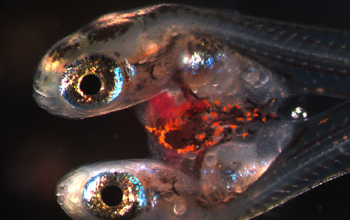Multimedia Gallery
Gulf killifish embryos exposed to sediments in Gulf of Mexico
Gulf killifish (Fundulus grandis) embryos exposed to sediments from oiled locations in the Gulf of Mexico in 2010 and 2011 show developmental abnormalities, including heart defects, delayed hatching and reduced hatching success.
More about this image
Researchers at the University of California, Davis, working in collaboration with researchers from Louisiana and South Carolina, discovered that crude oil toxicity continued to sicken the killifish for at least more than a year after the Deepwater Horizon oil spill in the Gulf. Researchers collected fish from an oiled site as well as exposed killifish embryos in the lab to sediment collected from oiled sites at Isle Grande Terre within Barataria Bay, Louisiana.
Killifish--a sentinel Gulf Coast species-- are an environmental indicator species, used to predict broader exposures and health risks. The findings are part of an ongoing collaborative effort to track the impact of the Deepwater Horizon oil spill on Gulf killifish populations in areas of Louisiana that received heavy amounts of oil. The research was supported in part by grants from the National Science Foundation (DEB 10-48206 and DEB 1120512).
To learn more about this research, see the UC-Davis news story
Health defects found in fish exposed to Deepwater Horizon oil spill. (Date of Image: 2012)
Credit: Benjamin Dubansky, Louisiana State University
See other images like this on your iPhone or iPad download NSF Science Zone on the Apple App Store.
Images and other media in the National Science Foundation Multimedia Gallery are available for use in print and electronic material by NSF employees, members of the media, university staff, teachers and the general public. All media in the gallery are intended for personal, educational and nonprofit/non-commercial use only.
Images credited to the National Science Foundation, a federal agency, are in the public domain. The images were created by employees of the United States Government as part of their official duties or prepared by contractors as "works for hire" for NSF. You may freely use NSF-credited images and, at your discretion, credit NSF with a "Courtesy: National Science Foundation" notation.
Additional information about general usage can be found in Conditions.
Also Available:
Download the high-resolution JPG version of the image. (1.3 MB)
Use your mouse to right-click (Mac users may need to Ctrl-click) the link above and choose the option that will save the file or target to your computer.

